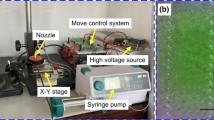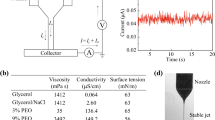Abstract
Droplet ejection from an electrohydrodynamic (EHD) inkjet nozzle depends on many factors such as an onset voltage, liquid conductivity, surface tension, etc. Since the surface tension has an influence on the contact angle between the nozzle surface and the liquid droplet, the surface tension change should be investigated for the control of the droplet ejection. In this study, surfactant, which can weaken the surface tension force, was used to analyze the effect of the surface tension. Furthermore, hydrophobic coating of the nozzle surface was considered as another factor for the droplet ejection. Also, a flow visualization technique was developed to observe the droplet formation and ejection from the EHD inkjet nozzle by various surface tension values.
Similar content being viewed by others
References
A. R. Jones and K. C. Thong, The production of charged monodisperse fuel droplets by electrical dispersion. J. Phys. D: Appl. Phys., 4 (1971) 1159.
D. H. William and E. C. Humphery, The drop weight method for the determination of surface tension, J. Am. Chem. Soc., 38(2) (1916) 228–236.
M. Mart’inez-S’anchez, 16.522 space propulsion, in MIT OpenCourseWare (2004).
P. Lozano, M. Martinez-S’anchez and J. M. Lopez-Urdiales, Electrospray emission from nonwetting flat dielectric surfaces, Journal of Colloid and Interface Science, 276 (2004) 392–399.
I. Marginean, From chaotic cone pulsation to ion evaporation in electrosprays, Dissertation, Faculty of Columbian College of Arts and Sciences, The George Washington University, August 31 (2006).
D. Poncelet, R. J. Neufeld, M. F. A. Goosen, B. Burgarski and V. Babak, Formation of microgel beads by electric dispersion of polymer solutions, AIChE Journal, 45(9) (1999) 2018–2023.
I. Hayati, A. I. Bailey and TH. F. Tadros, Investigations into the mechanisms of electrohydrodynamic spraying of liquids, I. Journal of Colloid and Interface Science, 117(1) May (1987).
Y. J. Kim, H. S. Ko, S. Lee, S. U. Son, D. Jung and D. Byun, Numerical and experimental analysis of electrostatic ejection of liquid droplet, Journal of the Korean Physical Society, 51 (2007) 42–46.
D. Poncelet, V. G. Babak, R. J. Neufeld, M. F. A. Goosen and B. Burgarski, Theory of electrostatic dispersion of polymer solutions in the production of microgel beads containing biocatalyst, Advances in Colloid and Interface Science, 79 (1999) 213–228.
A. Speranza and M. Ghadiri, Effect of electrostatic field on dripping of highly conductive and viscous liquids, Powder Technolohy, 136–135 (2003) 361–366.
S. Eri, K. Fumio, D. Jun, M. Tatsushi and Y. Hideo, Preparation of microcapsules by electrostatic atomization, Journal of Electrostatics, 66(5–6) (2008) 312–318.
S. W. Matthias and M. Mathias, Electrocspray and Taylorcone theory, Dole’beam of macromolecules at last, International Journal of Mass Spectrometry and Ion Processes 136 (1994) 167–180.
Y. H. Kim and D. T. Wasan, Dynamic surface tension of ionic surfactant solution, Journal of Ind. & Eng. Chemistry, 3(2) June (1997) 119–127.
T. O. Junpei, T. Ishikawa, Y. Watanabe and P. F. Paul, Surface tension and viscosity of molten vanadium measured with an electrostatic levitation furnace, J. Chem. Thermodynamics, 42 (2010) 856–859.
Y. Y. Zuo, C. Do and A. W. Neumann, Automatic measurement of surface tension from noisy images using a component labeling method, Colloids and Surfaces A, Physicochem. Eng. Aspects, 299 (2007) 109–166.
M. G. Cabezas, A. Bateni, J. M. Montanero and A. W. Neumann, Determination of surface tension and contact angle from the shapes of axisymmetric fluid interfaces without use of apex coordinates, Langmuir (2006) 22.
Author information
Authors and Affiliations
Corresponding author
Additional information
Han Seo Ko is an Associate Professor in the School of Mechanical Engineering, Sungkyunkwan University, Korea. He received his Ph.D in Mechanical Engineering in 1998 from Texas A&M University. His research interests are microfluidics, optical tomography and micro-droplet ejection.
Soo-Hong Lee is a graduate student (Ph.D) in the School of Mechanical Engineering, Sungkyunkwan University, Korea. His research interests are electrohydro-dynamics for inkjet, flow visualization technique, micro/nano fludics and computational fluid dynamics.
Xuan Hung Nguyen is a graduate student (Ph.D) in the School of Mechanical Engineering, Sungkyunkwan University, Korea. He received his master’s degree in Mechanical Engineering in 2009 from Sungkyunkwan University. His research interests are optical tomography, microdroplet ejection and loop heat pipe.
Rights and permissions
About this article
Cite this article
Lee, SH., Nguyen, X.H. & Ko, H.S. Study on droplet formation with surface tension for electrohydrodynamic inkjet nozzle. J Mech Sci Technol 26, 1403–1408 (2012). https://doi.org/10.1007/s12206-012-0301-y
Received:
Revised:
Accepted:
Published:
Issue Date:
DOI: https://doi.org/10.1007/s12206-012-0301-y




